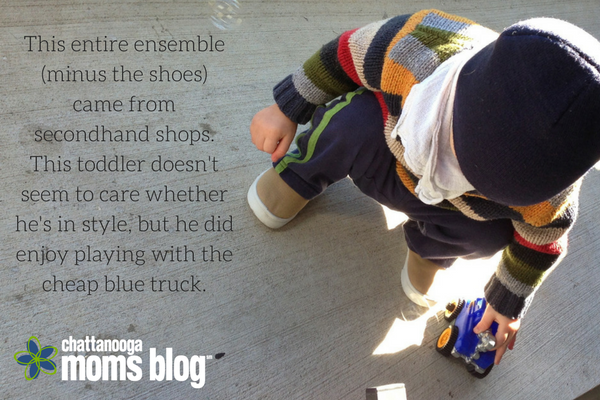
The week before I started kindergarten, I had one outfit to my name. ONE. My father had been laid off from his job, and whatever hand-me-downs I had from my older brother, no longer fit. Somewhat miraculously, my mother discovered a thrift store that had recently opened in the basement of someone’s home, and she walked out with a garbage bag full of clothes for both of us kids, for practically peanuts.
Ever since then, I have shopped for clothing at thrift stores.
Growing up, it was out of necessity. Even once I started to make my own money, I realized that buying used clothing provided more on my meager budget. I was also a little bit of an environmental nut as a teenager, so buying used stuff help to ease my conscious about over consumption and recycling.
Over time, I’ve purchased more new items from stores, but I still haven’t lost my thrifting game. As with any sport, bargain shopping for used items requires a few ground rules. With spring consignment sales around the corner, here are a dozen rules you should know before your thrifting game begins:
1. PRE-GAME RESEARCH
Sign up for email alerts for local consignment shops, or join Facebook pages announcing various sales. Many consignment sales offer perks for volunteering or selling your own stuff, like tickets to pre-sales before they open to the public. Some offer first time mom sales. Others often run half price deals on their last day. I often wait until the last day if I’m just buying clothes, simply to steer clear of the crowds. If you’re looking for a big-ticket item, like a double stroller, you probably shouldn’t wait that long.
2. FOCUS
Know what you’re looking for. If you need 3T pajamas for your toddler, steer clear of the jackets. This is easier said than done. When I was still pregnant with the Peanut, I had no idea what I needed. I bought ALL the cute clothes at my first mommy consignment sale. I had a big reality check when my summer baby outgrew every single cute winter item I’d bought for him before October even rolled around. I was oblivious to how quickly babies grew. Now, I wait until I can see his belly button stick out of his shirts to shop for bigger clothes. Beware of stocking up. Besides, you really don’t need all of that baby junk.
3. QUALITY CONTROL
Look closely at the item you’re purchasing. Many consignment sales have strict quality requirements — some thrift stores, not so much. Make sure the item you’re purchasing is free of rips and stains and ensure the zippers actually work (unless you’re handy with a sewing machine, and even then, decide if it’s worth the extra work you’ll have to put into the garment).
4. SIZE IT UP
Sizes tend to change throughout the years, as do brands. Most shrinkable items will have already shrunk by the time they reach a used sale. Bring a tape measure and your child’s measurements. Every clothing brand has different sizing and it doesn’t always make sense. My 90th percentile giant 2.5 year old can still wear a 12-18 month Old Navy puffy vest, but he’s outgrowing 4T Gerber Onesies. (Yes, I too am puzzled by this.)
5. PRACTICE
Consignment sales usually run in seasons — most often, spring and fall, although a few are year-round. Thrift stores are constantly adding stock, so you’ll need to check back regularly. The latter are often cheaper for toys and clothing, but there is far less of a selection.
6. WATCH THE CLOCK
Give yourself a time limit. The longer you’re in there browsing, the more stuff you’ll find, which might not always be a good thing. After so many minutes of shopping, you have a good chance of adding cute little sandals that won’t fit your child by summer, into your shopping cart.
7. CALCULATE
Think twice about buying something just because it’s cheap. Some people say you shouldn’t buy a secondhand item unless you’re willing to pay full price for it if you had the money. I disagree slightly with that one…the whole point of thrifting is to NOT pay full price. If you don’t truly love the item, do NOT buy it, just because it’s 50 cents. Hang it back up. However, if you simply HAVE to have the used fireman raincoat for $10 (true story) then by all means, splurge.
8. ACT FAST
When you see something you want, buy it. Unless it’s a shop that sells overstocks or donations directly from department stores, that one shirt in your child’s size is probably the only one there.
9. SUBSTITUTIONS
If you can’t make a sale, send a scout, or someone who can shop in your stead. Likewise, if you have a friend you know who needs a high chair, be on the lookout if you’re at the sale first.
10. TEAMWORK
Bring a friend or family member to help you wrangle both your children and your bags, or find a babysitter for your shopping excursion. Consignment sales don’t often have shopping carts, and many pre-sales only allow children in a carrier, not a stroller.
11. REPLACEMENTS
In my quest to minimize my stuff, I have a rule that if I buy something, I need to get rid of an equivalent item in my closet. This rule doesn’t apply as much with children’s stuff, simply because they outgrow things so fast, and you’ll most likely be replacing their stuff soon in any case. Nevertheless, check yourself. Does your child really need four winter coats? Probably not. Now hang up that extra one you’re about to buy.
12. OVER-CONSUMPTION
Finally, if the item you purchased sits in the closet for too long without being used, resell it or donate it. I guarantee when you see your item on the rack at the next sale, you’ll think twice about buying too much stuff.





















